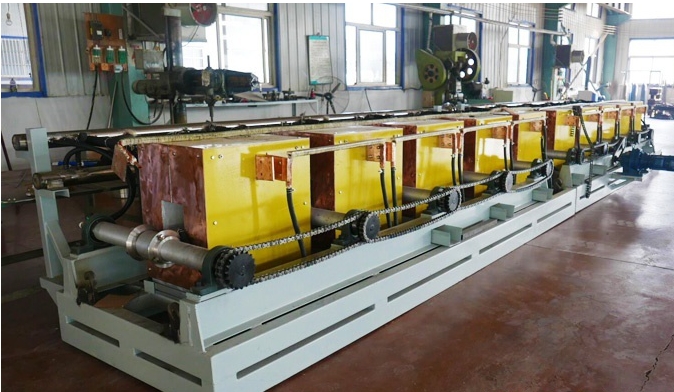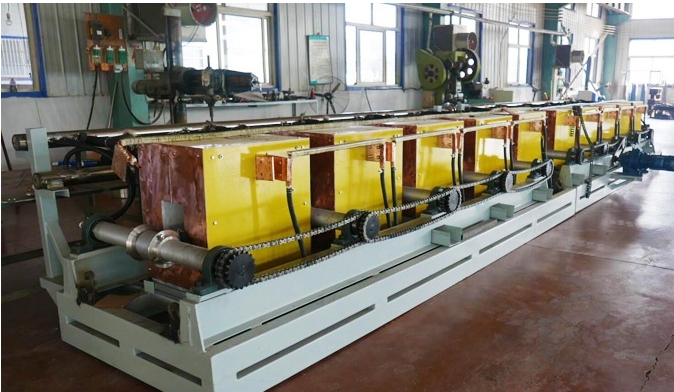- 08
- Jan
Operating Instructions for Quenching and Tempering Furnace
Operating Instructions for Quenching and Tempering Furnace
Manually hoist the whole bundle of materials by a crane on the storage rack (at this time, the fork of the bulk bundle device is in a vertical position). Manually turn on the two-position five-way solenoid valve, the cylinder piston rod shrinks, the fork rod rotates, and when it is in place, the loose bundles are opened, and the heated steel pipes will automatically roll to the feeding place of the separation mechanism. Once there is no material, there will be no The material detection switch sends out a signal. Under the control of the control system, the separation mechanism sends out the materials one by one according to the beat, and rolls to the end for positioning. The feeding detection switch receives the signal, and the feeding lifting and translation mechanism works. First, the lifting oil cylinder is jacked up, and after holding the steel pipe in place, a signal is sent, the piston rod of the translation oil cylinder is extended, and the material is translated to the center of the two rollers, when it is in place, a signal is given, and the piston rod of the translation oil cylinder is contracted in place. The feeding, lifting and translation mechanism returns to the original position and waits for the next instruction.
The double support rod drive system is divided into three zones, namely the feeding zone, the heating zone and the discharging zone. There are 12 pairs of double support rod transmission systems in the feeding area, 14 pairs of double support rod transmission systems in the heating area, and 12 pairs of double support rod transmission systems in the discharge area, totaling 38 groups. Each zone is equipped with a set of frequency converter and an angle-adjusting motor, which is controlled by the feeding roller to connect the steel pipe end to end. When the end of the steel pipe is about to leave the front port of the first section of the heating furnace, if there is no material, the feed detection switch will send a signal and the separation mechanism will work once. If the pipe is stuck (when the steel pipe is still), the feed detection switch will send out an alarm signal.
The speed of the double-supporting rod transmission system in the heating zone is a predetermined value according to the steel pipe specifications. When the steel pipe passes the first set of sensors (750KW), the temperature of the steel pipe should be heated to about 500°C (infrared thermometer is installed here) When the steel pipe enters the 100KW sensor, the temperature of the steel pipe should be heated to 930℃ (the infrared thermometer is installed here), the steel pipe enters the water mist spray area, the spray in-position detection switch is turned on, and then it enters the spray area , The spray in-position detection switch is turned on, and then it enters the spray drying area, the spray-dry area in-position detection switch is turned on, and finally enters the tempering sensor (750Kw), and an infrared thermometer is also installed at the exit of the tempering sensor, and the final inspection The tempering temperature of the steel pipe.
The speed of the double support rod transmission system in the discharging zone is the same as the transmission speed of the heating zone, but when the end of the steel pipe is about to leave the last set of double support rods in the heating zone, the discharge zone detection switch sends a signal, and the discharge zone double support rods The transmission speed is accelerated, and the heating steel pipe is quickly pulled out, so that the distance between the first and last steel pipes is stretched. Finally, the steel pipe is blocked by the blocking mechanism, and a signal is sent out, and the discharge lifting and translation mechanism works.
When the discharge lifting and translation mechanism receives a signal, the piston rod of the lifting cylinder first contracts, and the material holding mechanism simultaneously lifts the tempered steel pipe. After it is in place, the translation cylinder piston extends and reaches the end point (ie, the two-way cooling bed position). The cooling bed dragging device and the rotating device automatically stop working at the same time. When the discharging lifting and translation mechanism puts the material down steadily, the two-way cooling bed restarts its work. The discharge lifting and translation mechanism returns to the original position and waits for the next instruction.
The working state of the steel pipe in the two-way cooling bed is: both stepping and rotating. When the stepping reaches the end point, the steel pipe rolls onto the collecting platform (the temperature of the steel pipe is less than or equal to 150°C) and is blocked by the fork of the hardening device. If hardening is required, it can be done manually. After the hardness is hit, the two-position five-way electromagnetic is switched on, the pneumatic piston rod shrinks, and the steel pipe rolls to the end of the collecting platform and is stopped. After the material is full, it is manually tied up and lifted away, and the next process is continued.

Operating Instructions for Quenching and Tempering Furnace
Manually hoist the whole bundle of materials by a crane on the storage rack (at this time, the fork of the bulk bundle device is in a vertical position). Manually turn on the two-position five-way solenoid valve, the cylinder piston rod shrinks, the fork rod rotates, and when it is in place, the loose bundles are opened, and the heated steel pipes will automatically roll to the feeding place of the separation mechanism. Once there is no material, there will be no The material detection switch sends out a signal. Under the control of the control system, the separation mechanism sends out the materials one by one according to the beat, and rolls to the end for positioning. The feeding detection switch receives the signal, and the feeding lifting and translation mechanism works. First, the lifting oil cylinder is jacked up, and after holding the steel pipe in place, a signal is sent, the piston rod of the translation oil cylinder is extended, and the material is translated to the center of the two rollers, when it is in place, a signal is given, and the piston rod of the translation oil cylinder is contracted in place. The feeding, lifting and translation mechanism returns to the original position and waits for the next instruction.
The double support rod drive system is divided into three zones, namely the feeding zone, the heating zone and the discharging zone. There are 12 pairs of double support rod transmission systems in the feeding area, 14 pairs of double support rod transmission systems in the heating area, and 12 pairs of double support rod transmission systems in the discharge area, totaling 38 groups. Each zone is equipped with a set of frequency converter and an angle-adjusting motor, which is controlled by the feeding roller to connect the steel pipe end to end. When the end of the steel pipe is about to leave the front port of the first section of the heating furnace, if there is no material, the feed detection switch will send a signal and the separation mechanism will work once. If the pipe is stuck (when the steel pipe is still), the feed detection switch will send out an alarm signal.
The speed of the double-supporting rod transmission system in the heating zone is a predetermined value according to the steel pipe specifications. When the steel pipe passes the first set of sensors (750KW), the temperature of the steel pipe should be heated to about 500°C (infrared thermometer is installed here) When the steel pipe enters the 100KW sensor, the temperature of the steel pipe should be heated to 930℃ (the infrared thermometer is installed here), the steel pipe enters the water mist spray area, the spray in-position detection switch is turned on, and then it enters the spray area , The spray in-position detection switch is turned on, and then it enters the spray drying area, the spray-dry area in-position detection switch is turned on, and finally enters the tempering sensor (750Kw), and an infrared thermometer is also installed at the exit of the tempering sensor, and the final inspection The tempering temperature of the steel pipe.
The speed of the double support rod transmission system in the discharging zone is the same as the transmission speed of the heating zone, but when the end of the steel pipe is about to leave the last set of double support rods in the heating zone, the discharge zone detection switch sends a signal, and the discharge zone double support rods The transmission speed is accelerated, and the heating steel pipe is quickly pulled out, so that the distance between the first and last steel pipes is stretched. Finally, the steel pipe is blocked by the blocking mechanism, and a signal is sent out, and the discharge lifting and translation mechanism works.
When the discharge lifting and translation mechanism receives a signal, the piston rod of the lifting cylinder first contracts, and the material holding mechanism simultaneously lifts the tempered steel pipe. After it is in place, the translation cylinder piston extends and reaches the end point (ie, the two-way cooling bed position). The cooling bed dragging device and the rotating device automatically stop working at the same time. When the discharging lifting and translation mechanism puts the material down steadily, the two-way cooling bed restarts its work. The discharge lifting and translation mechanism returns to the original position and waits for the next instruction.
The working state of the steel pipe in the two-way cooling bed is: both stepping and rotating. When the stepping reaches the end point, the steel pipe rolls onto the collecting platform (the temperature of the steel pipe is less than or equal to 150°C) and is blocked by the fork of the hardening device. If hardening is required, it can be done manually. After the hardness is hit, the two-position five-way electromagnetic is switched on, the pneumatic piston rod shrinks, and the steel pipe rolls to the end of the collecting platform and is stopped. After the material is full, it is manually tied up and lifted away, and the next process is continued.

